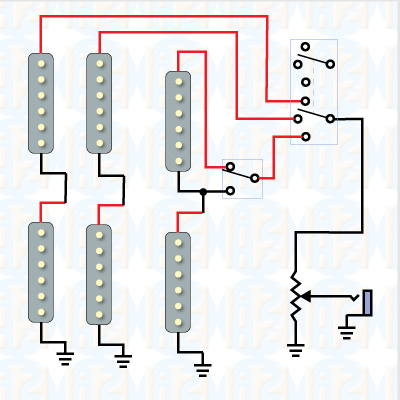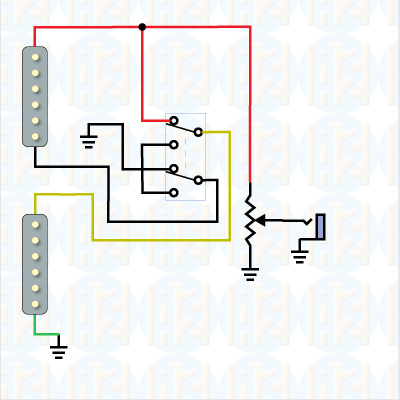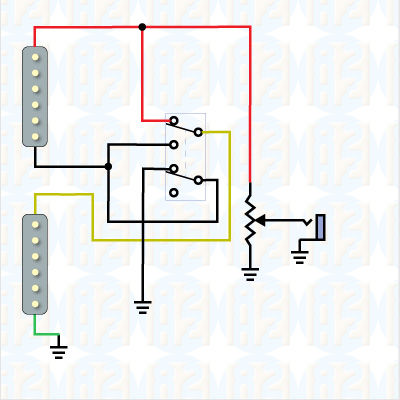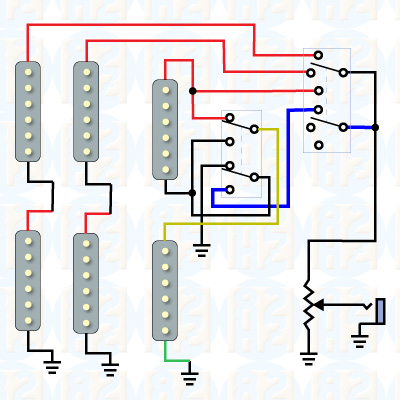Guitar wiring basics, part three
This is part three of a two part series. It grew.
Just like parts one and two, this will not cover specific guitars or the details of how pickups and volume controls work. It is intended to fill in for what I found to be some missing areas in the many websites that talk about guitar electronics.
Well, except for The Payoff.
More and more options
If one pickup was good and two were better, it didn't take too long to get to using three. To select between those three pickups, a three-way switch was used. Part one of this series briefly described how a three-way switch works. Using a standard Stratocaster as an example:
- Each pickup connects to the switch.
- The switch selects which pickup provides the signal.
- That signal connects to a one tone and one volume control.
Somebody, I'd like to think it was Jimi Hendrix, found that you could get a very interesting tone by balancing the switch between two of the three positions; doing this selected two pickups at once. It was kind of awkward trying to find that magic spot where both pickups were selected. It didn't take much for the switch to slip back and select only one pickup. And so, the five-way switch was born.
The five-way switch is nothing more than a three-way switch with detents that help the switch stop in those in-between positions where two pickups are selected.
Let's have a three-way
It's time to make a jump and combine two of the concepts from part one. We'll add a third pickup to the pickup selector in Figure 3, so a three-way switch will be used. Actually, we'll use a five-way, but saying three-way makes for a lot catchier title.
For that third pickup we'll use the humbucker from Figure 4. To keep the split-coil option from that figure, a separate switch needs to be added.

The results are shown in Figure 6. Add your choice of tone controls, one for each pickup. Or change it by putting more volume controls before the three-way switch.
One thing to notice is that only half of the 5-way switch is actually used. You would never guess this if you look at a lot of guitar wiring diagrams. I'll take advantage of this later when I create some new custom connections.
Series and parallel connections
When using both of their pickups, there are two ways to wire humbuckers. We'll be ignoring split-coil connections for a while. In these articles so far, and as most commonly used in guitars, the two pickups have been wired in series. That means that the two pickups are connected together in one place only, like the connection that was made in Figure 4 when the dual-coil configuration was selected.

There is another way to wire a humbucker, and that is with the pickups in a parallel connection. In a parallel configuration the wires from both pickups are connected together. Figure 7 shows a way to use a switch that will allow either type of wiring.
It's fairly easy to follow the wiring and trace out the series connection that we've been using if you imagine the switch in the opposite position from the diagram. The switch is shown in the parallel position.
Saving some money

The guitar you've decided to take apart was probably mass-produced, and in that environment every penny counts. A lot of pennies are saved by eliminating one solder connection, so you're more likely to see the switch wired as shown in Figure 8.
It turns out that we can use this savings to get some new sounds because there is now an unused connection on that switch.
What could that empty spot be used for? It only gets a signal when the switch is in the series position. In that position, it is connected to the point where we would be getting coil-splitting.
We're going to use the empty connection to get the signal from the bottom pickup in the diagram when the humbucking pickup is not selected.
The payoff
Compare Figure 9 to Figure 6 and the main difference you'll see it that the SPDT split-coil switch was replaced with a DPDT series/parallel switch. That switch is wired like Figure 8, except it uses the top half of the switch instead of the bottom half.

The change that gives the new sounds is the addition of two connections. They are the slightly heavier blue wires. One connects the "Z" terminals together. The other connects what was the unused connection on the series parallel switch to the unused portion of the three-way pickup selection switch.
For those of you with a guitar that has a three-way switch and a series parallel/switch, this modification probably means adding just one wire. It seems that although some manufacturers are saving money by using the reduced-wiring series/parallel connections, they often wire the two Z terminals (as I've been calling them) together.
What does it do?
To describe what this wiring does, I'm going to label the pickups A, B and C, starting from the left in Figure 9. That makes the humbucker with the coil-splitting switch Pickup C. Pickups A and B are shown as humbuckers, but they could also be the single-coil type.
First, what does this modification not do? The addition has no effect when the series/parallel switch is in the parallel position. It also has no effect when Pickup C is selected, no matter what position the series/parallel switch is in. That means that all of the original sounds are still available as if the modification had never been made.
Two conditions have to be met for the new connections to have any effect:
- Pickup A must be selected, either alone or in the mid-position that also selects Pickup B.
- The series/parallel switch must be in the series position.
If those conditions are met, then the bottom coil of Pickup C is also selected. That results in having the ability to have all three pickups selected, or to have Pickups A and C selected. The only limitation is that Pickup C will be in split-coil mode.

Wrap-up
"The Payoff" of getting these new sounds is why this series was really written.
I had a guitar with two single-coil pickups and a humbucker. I knew something sounded wrong with it, so I took it apart. The innards looked wrong, but I had to learn how five-way switches work to figure out what the problem was. Yep, the guitar had been wired incorrectly. With my newfound knowledge I fixed it and also saw the opportunity to add some new sounds.
And now you know how to do it, too!


